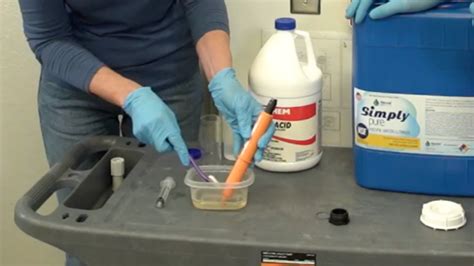How To Lower Orp In Pool
Ronan Farrow
Apr 01, 2025 · 3 min read

Table of Contents
How to Lower ORP in Your Pool: A Comprehensive Guide
Maintaining a healthy swimming pool involves regular monitoring and adjustments of various water parameters. One crucial factor often overlooked is Oxidation Reduction Potential (ORP). High ORP levels can indicate excessive sanitizer levels, leading to potential issues like irritated skin and damage to pool equipment. This guide explains how to effectively lower ORP in your pool and maintain a safe and enjoyable swimming experience.
Understanding ORP in Pool Water
ORP, measured in millivolts (mV), indicates the pool's oxidizing power. A high ORP signifies a strong oxidizing environment, usually caused by high sanitizer levels (chlorine, bromine). Conversely, a low ORP indicates a weaker oxidizing environment, potentially leaving your pool vulnerable to algae and bacteria growth. The ideal ORP range for a properly sanitized pool typically falls between 650mV and 750mV. However, this can vary slightly depending on your specific pool and sanitizer type.
Why High ORP is a Problem
While you want sufficient sanitation, excessively high ORP levels are problematic for several reasons:
- Irritated Skin and Eyes: High sanitizer levels can cause burning eyes and irritated skin, making swimming unpleasant.
- Equipment Damage: Overly strong oxidizers can damage pool components, such as pumps, filters, and liners, leading to costly repairs.
- Chemical Imbalance: High ORP often reflects an imbalance in other water chemistry parameters, requiring further adjustments.
Effective Ways to Lower ORP in Your Pool
Lowering high ORP primarily involves reducing the sanitizer level in your pool. Here's a breakdown of effective methods:
1. Dilute the Sanitizer
The most straightforward approach is to simply dilute the sanitizer concentration. This might involve:
- Partially draining and refilling: This is effective but time-consuming and requires significant water usage.
- Adding fresh water: Adding fresh water to your pool will dilute the sanitizer concentration. However, this method might also affect other water chemistry parameters.
Caution: Always test your pool water before and after any adjustments. Avoid making drastic changes; instead, opt for gradual adjustments to monitor the impact effectively.
2. Optimize Filtration System
A well-functioning filtration system plays a critical role in maintaining proper water chemistry. Ensure your:
- Filter is clean: Regularly backwash or clean your filter to ensure efficient removal of debris and contaminants.
- Pump is functioning correctly: Proper pump operation facilitates efficient water circulation and sanitation distribution.
3. Check and Balance Other Water Chemistry Parameters
High ORP is often linked to imbalances in other parameters like pH, alkalinity, and calcium hardness. It is crucial to check and adjust these before or after addressing ORP levels:
- pH: Maintain your pH level within the optimal range (7.2 - 7.8). Use pH increaser or decreaser to fine-tune the pH.
- Alkalinity: Maintain your total alkalinity within the recommended range. This provides a buffer that helps to stabilize your pH.
- Calcium Hardness: Appropriate calcium hardness prevents scaling and corrosion.
Important: Always test your water using a reliable testing kit before making any adjustments to your pool chemistry.
4. Consider Using a Reducing Agent
In some cases, a chemical reducing agent like sodium thiosulfate can be used to neutralize excess chlorine or bromine, thus lowering the ORP. However, this should only be done under the guidance of a pool professional. Incorrect usage of reducing agents can lead to undesirable outcomes.
Preventative Measures to Maintain Ideal ORP
Proactive steps are more effective than reactive measures:
- Regular Water Testing: Conduct regular water testing (at least once a week) to monitor ORP and other essential parameters.
- Consistent Sanitizer Level: Maintain your sanitizer level within the recommended range to prevent both high and low ORP.
- Proper Pool Maintenance: Regular cleaning and maintenance prevent contamination and minimize the need for excessive sanitizer.
By understanding the factors influencing ORP and implementing the strategies outlined above, you can effectively manage your pool water chemistry, ensuring a safe, clean, and enjoyable swimming experience for everyone. Remember to always prioritize safety and consult a pool professional if you're unsure about any aspect of pool maintenance.
Featured Posts
Also read the following articles
| Article Title | Date |
|---|---|
| How To Keep Shrimp Alive Overnight | Apr 01, 2025 |
| How To Price Estate Sale Items | Apr 01, 2025 |
| How To Make A Deer Skinning Rack | Apr 01, 2025 |
| How To Obtain Sora License In Nj | Apr 01, 2025 |
| How To Pass Saliva Drug Test For Meth | Apr 01, 2025 |
Latest Posts
Thank you for visiting our website which covers about How To Lower Orp In Pool . We hope the information provided has been useful to you. Feel free to contact us if you have any questions or need further assistance. See you next time and don't miss to bookmark.
